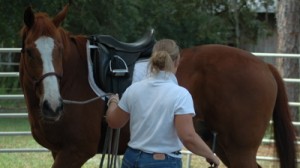Let’s be pragmatic. Compared to horses, we humans can’t compete if the test is one of brute strength. We need to enter the training arena with our wits about us and use our brains to get to the horse’s brain. The more we can get the horse to want to go along with our ideas the less strength we need in the equation. The males among us can afford to play power games with the horse, using their height and strength to their advantage. As such they are willing to take bigger risks that the more slightly built would be stupid to engage in. The smaller you are the smarter you need to be!
need to enter the training arena with our wits about us and use our brains to get to the horse’s brain. The more we can get the horse to want to go along with our ideas the less strength we need in the equation. The males among us can afford to play power games with the horse, using their height and strength to their advantage. As such they are willing to take bigger risks that the more slightly built would be stupid to engage in. The smaller you are the smarter you need to be!
What if there was a way to make a big impression on a horse without having to ‘get big’ in order to do it?
This is the first best reason to consider clicker training. Remember, clicker training isn’t a replacement for horsemanship skills. It justs gives us another tool toward achieving our primary goal: engaging the horse’s mind in the training process.
Lady was a big, stout 5 year old mare that I took into training. She’d already had some poor experiences at the hand of a so-called ‘trainer’. She’d actually been knocked unconscious as a result of being longed in side reins and flipped over. So, when she came to me she had already decided that the best defense was a good offense. I watched her interact with my other horses in the field. The gelding who pushed everyone else around couldn’t get her to back down. She kept fighting back. When I brought her into the round pen and moved her around a little bit I saw the same mentality. If the horses in the field couldn’t get a change in her by getting ‘big’ I had no chance. So, I started clicker training her.
It was like a light bulb went off in her head. Once I turned her on to the idea that the click meant ‘come get the food’ I started rewarding her for looking at me, following me, following a feel, moving forward, backing, moving laterally and so on. One or two times she tried to bowl me over and I needed to hold pretty firm. But when she got rewarded for backing off, she relaxed and let those thoughts go. You know that mare turned out to be a really sweet and reliable girl. And, this is the really interesting and heartwarming part, she stopped feeling like she needed to fight with the other horses too. It was like she just let all that worry go on every front. She was at peace.
Another way that many people have experienced the benefit of clicker training is when needing to deal with a horse who is recovering from an injury. The vet will prescribe x-amount of stall rest and then–HA!–hand walking for x-months. Riiiiight. And we do this how without the silly horse re-injuring himself?
A friend of mine had a 4 yr old Dutch WB who’s horse tore a suspensory ligament in a pasture incident. She wondered how on earth she was going to keep this athletic youngster calm enough to Just Walk when he wanted to be a kite at the end of the lead rope. So, she started clicker training him.
Once turned on to the game (which she started in a stall) she had a way to keep him sufficiently mentally stimulated that he didn’t need to bounce around like a fool and re-injure himself. He recovered from his injury and eventually she trained him to I1. Her experience with clicker training served her well throughout his continued training.
I know of numerous other similar examples of using clicker training as a means to engage the brain during a layup.
My philosophy is if it is this good for the infirm what’s to keep me from working with fit horses like this as well? Not a thing. 🙂 And that is the reason that I incorporate clicker training into the program with all horses I work with. Do I have to ? Not at all. But why tie one hand behind my back just to prove I can?
